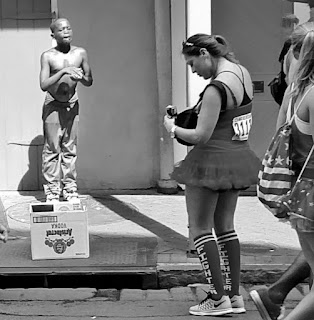 Dance like nobody's watching. Sing like nobody's listening. But write as if Syd Penner's looking over your shoulder.
Dance like nobody's watching. Sing like nobody's listening. But write as if Syd Penner's looking over your shoulder.Penner was a legendary copy editor for the New York Daily News in the pre-Internet era. While a Google search of my new Verizon colleague “Arianna Huffington” plus “Huffington Post” will yield about 456,000 results in 0.36 seconds, a similar search of Penner’s affiliation with the News yields just three results.
As Paul LaRosa notes, Penner wrote an internal newsletter called “The Printer’s Devil” about the craft of writing and telling stories on a deadline.
Late in his career, Penner also helped train new writers in NYNEX’s PR department – and I had my first news release drafts marked up by this unfailingly polite and obsessively thorough editor.
I should have kept souvenir copies of the handiwork of Jimmy Breslin’s editor, but instead I've salvaged only one old mimeographed copy of “The Printer’s Devil.” Read this, and you will appreciate immediately that, to Syd Penner, every word was precious.
Years later, another colleague – Steve Marcus, a former award-winning reporter for The New York Post – had the task of editing the copy produced by Verizon’s PR department. Marcus knew Penner well, and he had the same respectful touch in eviscerating all our news releases and blog posts.
I’ve seen many executives retire, and most are barely remembered the day after they leave. Such is the nature of business.
Yet Steve retired about two months ago (that's his empty office in the photo), and there’s still a gaping hole here. Such is the nature of art.
Without Penner and Marcus, we’re all on our own – and we’re scrambling. Many folks here have turned to our colleague Harry Mitchell for editing help in the interim, but Harry too is retiring from Verizon at the end of this week.
With the prospect of losing even Harry as a sanity check, another colleague, Libby Jacobson, recently sent me an email about a Techdirt article, “Comcast Really Wants Me To Stop Calling Their Top Lobbyist A ‘Top Lobbyist’.”
She bet I could come up with some tips based on that post, wherein a PR person parses the legal definition of the word “lobbyist” in defiance of common sense – and, in the process, generates much more unwanted attention.
I’ll take that bet, Libby.
Here are five tips to help writers in PR departments survive without a Syd Penner at their side:
1. Respect the Word.
A duck is a duck is a duck. A crash landing isn’t an anomaly. A lobbyist isn’t a chief diversity officer.
PR should simplify. That’s hardly ever the case, I know, because I’m also the author of Verizon’s earnings releases – but at least that should be the goal.
2. Keep Reading.
Even worse than PR is the Orwellian doublespeak of politics, and I highly recommend books such as Barton Swaim’s recent “The Speechwriter.” It’s interesting, and entertaining, to read about how politicians communicate – and politics is a field that, by its nature, is always on the leading edge of new communications and PR practices.
3. Keep Reading, Without Prejudice.
Still, it isn’t helpful to only read about things that could help you on the job. My wife is the most educated person I know – largely because she loves reading newspapers from cover to cover. She discovers new ideas because she isn’t only reading about things she thinks she wants to read about.
Recently, I read a marvelous memoir, “Another Little Piece of My Heart,” by the writer Richard Goldstein. His career path and point of view on many topics are seemingly the exact opposite of mine. Yet I was thrilled to read about his own Syd Penner – the legendary, and Google-famous, Clay Felker. Through the magic of the Internet, I even sent Richard a note about the book. He politely replied, and the universe didn’t implode.
4. Love Your Editor.
Everyone needs an editor. You should jump at any opportunity to work with someone to improve your writing. One organization I’m involved with – IABC’s New Jersey chapter – is hosting a day-long writing workshop with Ann Wylie, a talented editor who is well-known in PR circles. If you can be in Madison, NJ, on Sept. 21, there probably isn’t a better use of your time.
5. Handle Words With Care.
This has never been more important. Another magical side of the Internet is that every word you write now lives forever.
One of my favorite books (well, at least it had been a favorite before my wife and I raised two daughters) ends by evoking the secret of durable pigments.
One reason we all want to write and post and share is that we want to leave our mark on the world. Social media is the new durable pigment, and if we want to communicate something that has lasting value, we should choose our words wisely.
 |
| The only known photo of me and Harry Mitchell. |
That’s why, in this very sentence, I’ll simply mention the names of Harry Mitchell and Syd Penner.
Goodbye, Harry. We’ll miss you. I hope to be seeing you soon, forever linked with Mr. Penner, on Google.
---
This post originally appeared on LinkedIn.





